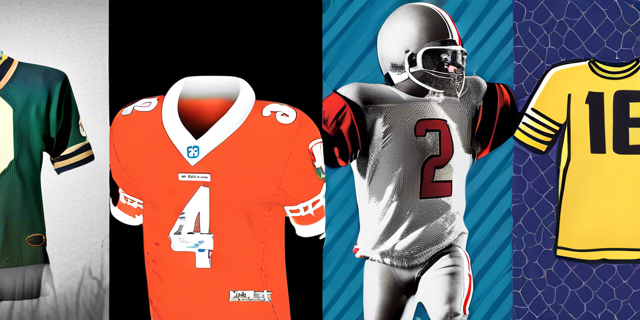The Evolution of Jerseys: From Classic to Modern

Introduction
Football jerseys have evolved significantly over the years, from simple cotton shirts to high-tech, moisture-wicking kits designed for peak performance. Jerseys are not just about style; they reflect the identity of a team, showcase sponsorships, and incorporate the latest sports technology.
In this article, we’ll explore how football jerseys have evolved, highlighting the key changes in materials, designs, branding, and technology over the decades.
1. The Early Years (1900s – 1950s): Wool and Simplicity
🔹 Material: Heavy wool or cotton
🔹 Fit: Loose and long-sleeved
🔹 Design: Plain colors with minimal details
In the early days of football, jerseys were made of thick wool to keep players warm in cold weather. These shirts were heavy, retained sweat, and lacked breathability, making them uncomfortable during matches.
🔹 Key Features:
✅ Simple solid colors
✅ Long sleeves and thick collars
✅ No logos or sponsors
One of the most famous jerseys of this era was England’s 1950 World Cup shirt, which was just a plain white cotton shirt with a simple Three Lions crest.
💡 Fun Fact: Footballers in the 1930s and 40s used to wear button-up jerseys—something unthinkable in today’s fast-paced game!
2. The 1960s – 1970s: Introduction of Synthetic Fabrics
🔹 Material: Polyester blends for lighter feel
🔹 Fit: Slightly tighter than wool jerseys
🔹 Design: More vibrant colors, first club logos appeared
In the 1960s, manufacturers began using polyester and nylon blends, making jerseys lighter, more breathable, and more comfortable. This was also when clubs started adding their crests to jerseys, marking the birth of team branding.
🔹 Key Features:
✅ Introduction of club crests on jerseys
✅ First use of synthetic materials
✅ More colorful and patterned designs
One of the most iconic jerseys from this era was Brazil’s 1970 World Cup kit, worn by Pelé. It was the first World Cup jersey made entirely of polyester.
💡 Did You Know? The 1970 World Cup was the first tournament broadcast in color, influencing the use of brighter jersey colors.
3. The 1980s – 1990s: Sponsor Logos and Bold Designs
🔹 Material: Lightweight polyester with improved breathability
🔹 Fit: More athletic, but still loose
🔹 Design: Bold colors, patterns, and sponsor logos
The 1980s and 1990s were a game-changer for football jerseys. This was when sponsor logos started appearing on jerseys, creating commercial opportunities for clubs. Brands like Adidas, Umbro, and Nike became major players in football fashion.
🔹 Key Features:
✅ First-ever sponsor logos on jerseys
✅ More creative patterns and color designs
✅ Lightweight, sweat-resistant fabrics
One of the most iconic jerseys of this period was Germany’s 1990 World Cup jersey, featuring a bold black, red, and yellow design across the chest.
💡 Fun Fact: Liverpool was one of the first clubs to feature a sponsor on their jersey, partnering with Hitachi in 1979.
4. The 2000s: Slim Fit and High-Tech Materials
🔹 Material: Sweat-wicking polyester (Dri-FIT, ClimaCool, AEROREADY)
🔹 Fit: Tighter and more athletic
🔹 Design: Simpler, sleeker styles with advanced printing
In the 2000s, jerseys became tighter and more form-fitting to enhance player performance. Brands like Nike and Adidas introduced moisture-wicking technology, helping players stay cool and dry.
🔹 Key Features:
✅ Slimmer, body-hugging fit
✅ Advanced sweat-wicking fabric
✅ More minimalistic designs
A great example is Barcelona’s 2008-09 kit, worn by Lionel Messi during their historic treble-winning season. This jersey featured Nike’s Dri-FIT technology, making it one of the most comfortable football shirts ever.
💡 Did You Know? Some jerseys from the 2006 World Cup used cooling zones in the fabric to regulate player temperature.
5. The 2010s – Present: Smart Jerseys and Customization
🔹 Material: Recycled polyester, ultra-lightweight fabrics
🔹 Fit: Tight, aerodynamic design for performance
🔹 Design: Smart technology, minimalistic aesthetics, and eco-friendly materials
In the modern era, jerseys are now made with cutting-edge technology. Brands have introduced eco-friendly jerseys made from recycled plastics. Some jerseys even feature NFC chips to scan for authenticity and access exclusive content.
🔹 Key Features:
✅ Smart jerseys with NFC chips and tracking data
✅ Sustainable materials (recycled plastics, ocean waste)
✅ Customization options (fan editions, name printing)
For example, Nigeria’s 2018 World Cup jersey became an instant classic because of its bold zigzag pattern and eco-friendly materials.
💡 Fun Fact: Nike and Adidas now create “Vapor” and “Authentic” versions of jerseys, where the player-issue kits have advanced cooling technology.
Conclusion
From wool shirts in the 1900s to today’s smart jerseys, football kits have come a long way. Every era has introduced new materials, designs, and technology to improve comfort and performance.
✅ The early jerseys were heavy wool shirts with no logos.
✅ The 1960s-70s saw the introduction of polyester and club crests.
✅ The 1980s-90s brought bold designs and sponsor logos.
✅ The 2000s introduced sweat-wicking fabrics and slim-fit designs.
✅ The 2010s-present focus on smart technology and sustainability.
Looking for classic and modern jerseys? Check out The Aurax for the latest collections!

